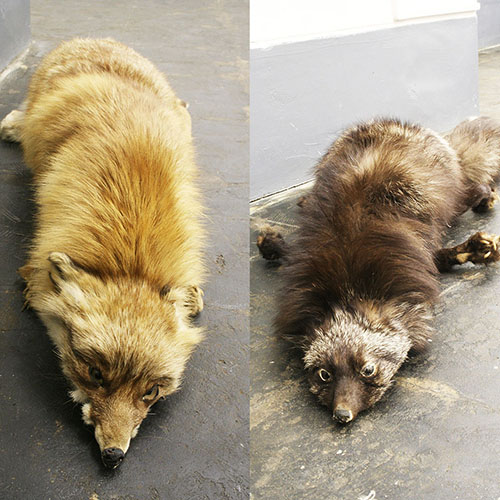Clone Rascal, Clone Aesop
2008
each 46 x 7 x 7 in. (W:117 D:18 H:18 cm)
taxidermy animal, electric toy, mixed media

A few years ago, I saw an AIBO on display in the window of a pawn shop. For some reason, I felt an inexplicable sadness. Why should I feel that way just from seeing an electronic appliance being sold? If it had been a lifelike doll resembling a living creature, I don’t think I would have felt the same sadness. Perhaps it was because I knew that this pseudo-pet appliance could actually move.
I remembered the catchphrase that was used when AIBO was first released: “It’s not made by Sony, it’s born from Sony.” A clever turn of phrase. I assumed that AIBO’s true ambition was to claim the position of a new kind of pet. Whether that was the company’s intent or not, I chose to interpret it that way—an initial step toward the world of Atom or Doraemon.
Their first priority must have been motion—the pursuit of movements so endearing that we could mistake them for those of a real pet. Next came artificial intelligence. But considering the enormous amount of time, resources, and cost required to advance AI, I doubt it was treated as the highest priority. If, however, AIBO had achieved movements indistinguishable from a real animal and gained intelligence on par with a pet, then the final frontier would have been its outward appearance—realistic fur, warmth, even smell. And if it had reached that point, could we still call it an appliance? Or would it mark the moment when robots finally established themselves as a new category of being? That is also when we would face questions of ethics, much like the debates over cloning, about what it means for something to be alive.
But perhaps that AIBO in the pawn shop window already carried a faint trace of life. And that is why, when I saw it, I felt a sadness I could not quite explain. Once I realized that, the catchphrase “It’s not made by Sony, it’s born from Sony” suddenly struck me as frightening.
The clones I create use actual taxidermy, so their outward appearance is perfectly realistic—in fact, it is real. In that sense, the priorities are reversed from AIBO’s: appearance is paramount, while movement is crude and underdeveloped. (And yet, this crawling, almost pitiful movement is vital to the work, for it conjures an impression of grief.) If I were to continue developing these clones, perhaps they would eventually achieve the charming motions of AIBO. And if Sony had continued developing AIBO, perhaps it would have eventually acquired the realistic appearance of these clones.
Seen this way, the final destination of both might have been the same.
(July.6.2008)
数年前に質屋のショウウィンドウにAIBOが売られているのを見かけた。その時何故かよくわかならい悲しい気持ちになった。何故電化製品が売られているだけでそんな気持ちになったのか、生き物そっくりの精巧な人形が売られていても悲しい気持ちにはならなかっただろう。僕はその売られている疑似ペット家電製品が動く事を知っているからか。
売り出し当時AIBOにこんなキャッチコピーがあったのを思い出した。「ソニー製ではない、ソニー生まれである。」うまくいうものだと思った。恐らくAIBOの目指すべき到達地点は新しいペットとしての座なのだろう。真意はどうであれ僕は勝手にそうに理解した。来るべきアトムやドラえもんの世界への一歩になるつもりなんだと。
まず取りかかったのは動作の追求。私たちがペットと錯覚できるように愛らしい動作を最優先したんだと思う。そして人工知能。しかしこれには更なる科学技術の為の膨大な時間と予算、結果製品としての価格を考えるとそう最重要課題ではなかったと思う。もし動作も本物と見紛う程になり、ペット並みの知能を獲得したならば、最後には外見だろう。精巧なフェイクファー、動物のような体温や臭い。もしそうなった時、私たちはそれを電化製品と呼べるのか。新しいカテゴリーとしてロボットの地位がついに確立されるのか。そして生命の存否が判断されるのか。その時になり、初めてクローン問題のように私たちの倫理観が問われる事になるのだろう。しかしそのショウウィンドウに陳列されたAIBOはすでに生命のかけらみたいなものを持ち始めていたのかもしれない。だから僕はそれを見た時、よくわからない悲しい気持ちになったんだと思う。そう思えるようになった時「ソニー製ではない、ソニー生まれである。」というキャッチコピーが途端に怖くなった。
僕の作ったクローンたちは剥製を使用しているので外見は本物のようにリアルである。(というよりも本物である。)つまりAIBOとはプライオリティーを反転させてある。外見が最重要視され、動作は軽視され稚拙。(この這いずり回る姿が悲痛さを連想されるので作品にとって重要なのではあるが)もしも僕がこのクローンを作り続ければいずれAIBOのような愛らしい動作をするようになるのかもしれない。もしもソニーがAIBOを作り続けていたならばいずれこのクローンたちのような外見になっていたのかもしれない。
そう考えればこの二つの目標到達地点は同じだったのかもしれない。
(2008/7/6)
Back